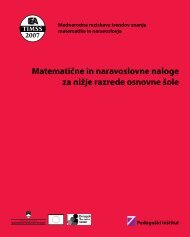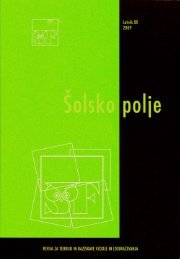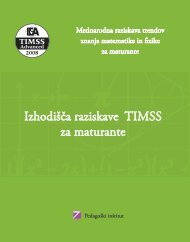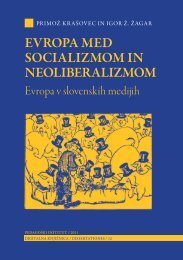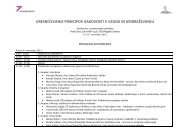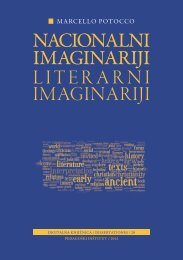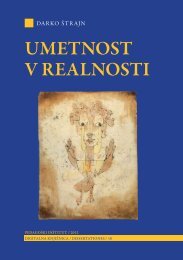Šolsko polje, letnik XX, številka 5-6, 2009: Vloga ... - Pedagoški inštitut
Šolsko polje, letnik XX, številka 5-6, 2009: Vloga ... - Pedagoški inštitut
Šolsko polje, letnik XX, številka 5-6, 2009: Vloga ... - Pedagoški inštitut
Create successful ePaper yourself
Turn your PDF publications into a flip-book with our unique Google optimized e-Paper software.
66 ŠOLSKO POLJE LETNIK <strong>XX</strong> ŠTEVILKA 5/6Commonplaces (topoi) are caracterised by their extreme generality,says Perelman (1958/1983: 112-113), which makes them usable in everysituation. It is the degeneration of rhetoric and the lack of interest for thestudy of places that has led to this unexpected consequences that »oratorydevelopments« - as he ironically calls them - against fortune, sensuality,laziness, etc., which school exercises were repeating ad nauseam becamequalified as commonplaces (loci, topoi), despite their extremly particularcharacter. By commonplaces we more and more understand, Perelmancontinues, what Giambattista Vico called »oratory places«, in order to distinguishthem from the places treated in Aristotle’s Topics. Nowadays,commonplaces are caraterised by banality which doesn’t exclude extremespecificity and particularity. These places are nothing more than Aristoteliancommonplaces applied to particular subjects, concludesPerelman. That is why there is a tendency to forget that (common)placesform an indispensable arsenal in which everybody who wants to persuadeothers should find what he is looking for.And that is exactly what is happening in DHA approach to topoi. Moreover,the works quoted in the first part of the article give the impressionthat DHA isn’t using the Aristotelian (or Ciceronian) topoi, but the so called»literary topoi« as developed by Ernst Robert Curtius in his EuropaeischeLiteratur und Lateinisches Mittelalter (1990: 62-105). And what is aliterary topos? Well, already oral histories passed down from pre-historicsocietes contain literary aspects, characters, or settings which appear againand again in stories from ancient civilizations, religious texts and evenmore modern stories. These recurrent (and repetetive) motives orleitmotifs would be labeled literary topoi. »They are intelectual themes, suitablefor development and modification at the orator’s pleasure«,argues Curtius (1990: 70). And topoi is one of the expressions Wodak isusing as synonyms for leitmotifs (<strong>2009</strong>: 119):»In the analysis of text examples which were recorded and transcribed Iwill first focus on the leitmotifs, which manifeste themselves in variousways: as topoi, as justification and legitimation strategies, as ruleswhich structure conversation and talk, or as recurring lexical items ...«For the New Rhetoric (Perelman/Olbrechts-Tyteca1958/1983: 113) topoiaren’t defined as places that hide arguments, but as very general premisesthat help us build values and hierarchies, something Perelman,whose background was jurisprudence, was especially concerned about.Perelman and Olbrechts-Tyteca therefore distinguish two main types of





